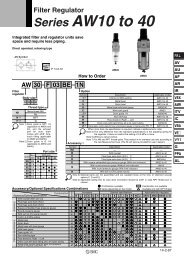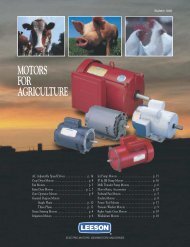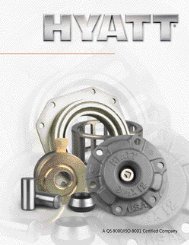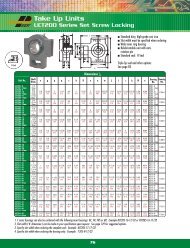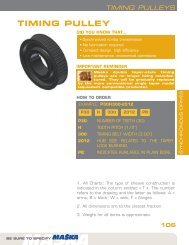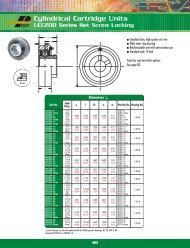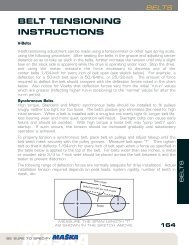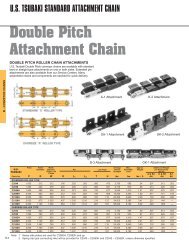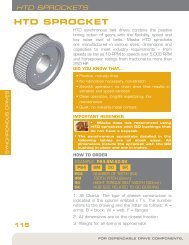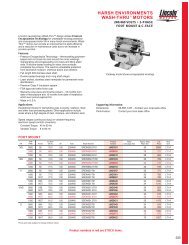Table of Contents - Rainbow Precision Products, Inc.
Table of Contents - Rainbow Precision Products, Inc.
Table of Contents - Rainbow Precision Products, Inc.
- No tags were found...
Create successful ePaper yourself
Turn your PDF publications into a flip-book with our unique Google optimized e-Paper software.
V-Belt InstallationProper installation techniques will assurethat you get full service life and minimumdowntime from your belt drives.1. Turn machine OFF and lock out power source.2. Remove belt guard, loosen motor mounts, andshorten center distance between sheaves.Remove old belts.3. Inspect, repair, or replace drive components.• Clean oil, grease, and debris from sheaves;remove rust with a wire brush.• Inspect and replace damaged sheaves.Get your money’s worth from a new set <strong>of</strong> beltsby checking and replacing worn or damagedsheaves. In the long run, replacement sheavecost will more than be recovered in increased beltlife, reduced downtime, and lower maintenanceexpense. Check the following:a) Worn groove sidewalls, “Dishing” should notexceed 1/32" for individual belts. With a Combobelt, dishing should not exceed 1/64". When aCombo belt rides too low in worn sheavegrooves, the tie band can be cut by the flangesbetween the grooves.Dishing5. Install new belts.• Loosen the drive take up and place the new belts onthe sheaves. Press the belts with your hand to positionthe slack <strong>of</strong> each belt on the same side <strong>of</strong> the drive. Ifthe slack is on different sides, start up loads can breakbelt tensile cords.• Do not pry or force belts on the sheave. This can breakthe load carrying tensile “muscle” <strong>of</strong> the belt, and thebelts will break or turn over shortly after installation.• Take up slack until the belts fit snugly.6. Check sheave alignment.• Place a straightedge or taut string across sheave facesto correct misalignment.• Check parallel position <strong>of</strong> shafts and correct alignment<strong>of</strong> grooves.• Note: Mount sheaves as close to bearings as possible.7. Tension belts. (See note below.)• Ideal tension for a V-belt drive is the lowest tension atwhich a belt will not slip under peak load.• Tension belts, replace belt guard, run the drive for 15minutes, and apply full load. Retighten slipping orsquealing belts.• Retension after 24 to 48 hours, when belts will becompletely seated in grooves.• Do not use belt dressing. If the belt slips, tightenand/or check for worn sheave grooves.Note: Store belts in a cool, dry place out <strong>of</strong> direct sunlight.Types <strong>of</strong> sheave and shaft misalignmentWorn Groove Sidewallsb) Shiny sheave groove bottoms. This is a sure signthat the belt has bottomed out. The resulting slippageshortens belt life.c) Wobbling and/or damaged sheaves. Generallycaused by improper sheave or bushing installation,wobbling and/or damaged sheaves canunbalance a drive, wear out belts rapidly, anddamage bearings.• Check and repair worn bearings and bent shafts.4. Select replacement belts.• Replace all belts on a drive with a new matchedset from one manufacturer.a) Do not mix old and new belts on a drive. A newbelt will ride higher in the sheave groove andoperate at a higher tension than an old belt.Running them together will damage the new beltso it cannot carry its share <strong>of</strong> the load.b) Do not mix belts from different manufacturers.Because dimensions and constructions will vary,running such “mis-matched” belts will not givefull service life.c) Replace with correct type and cross section belt.Match “A” section belts with “A” sheavegrooves, “B” to “B”, etc. Do not use “B” sectionbelts in “5V” sheaves, or vice versa. Neverreplace “A” or “B” belts with “4L” or “5L” fractionalhorsepower belts. Remember that dimensionallysimilar belts can have very differenthorsepower ratings.Horizontal AngularVertical AngularParallelRefer to page 117 for proper tensioning, values andmethods.Refer to page 34 for tensioning and alignment tools.116



